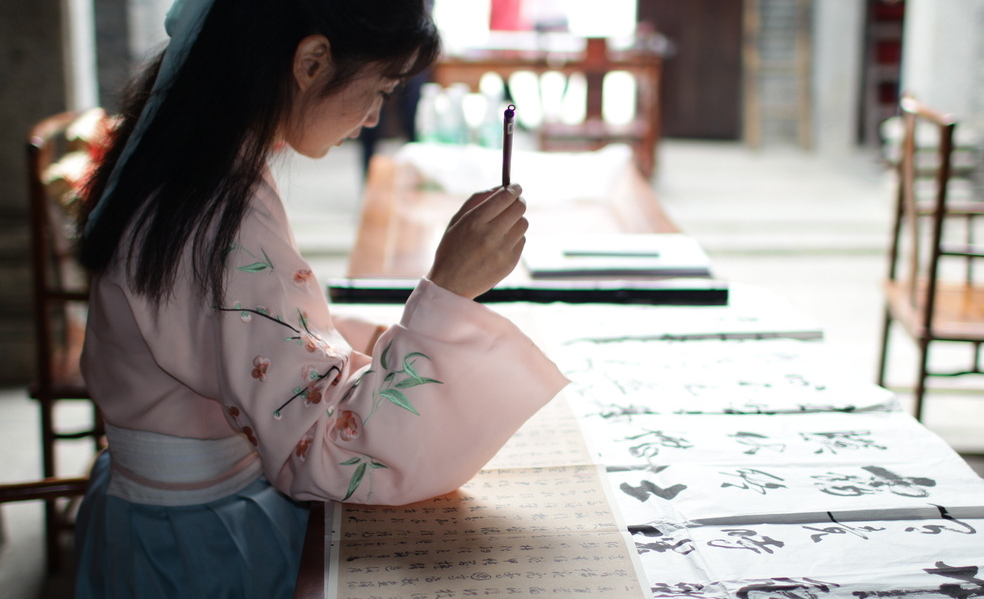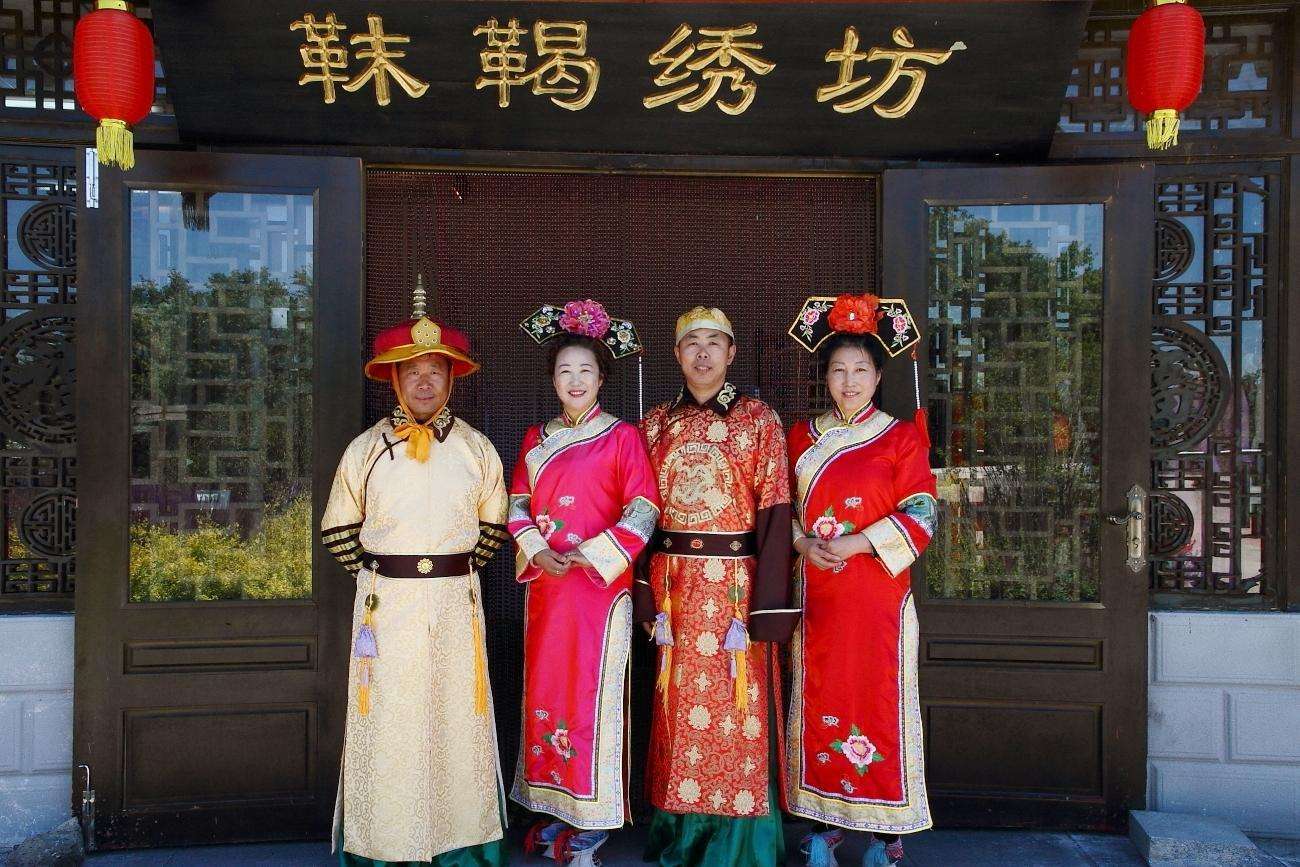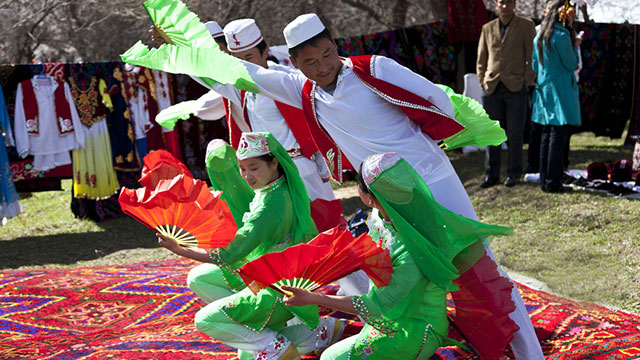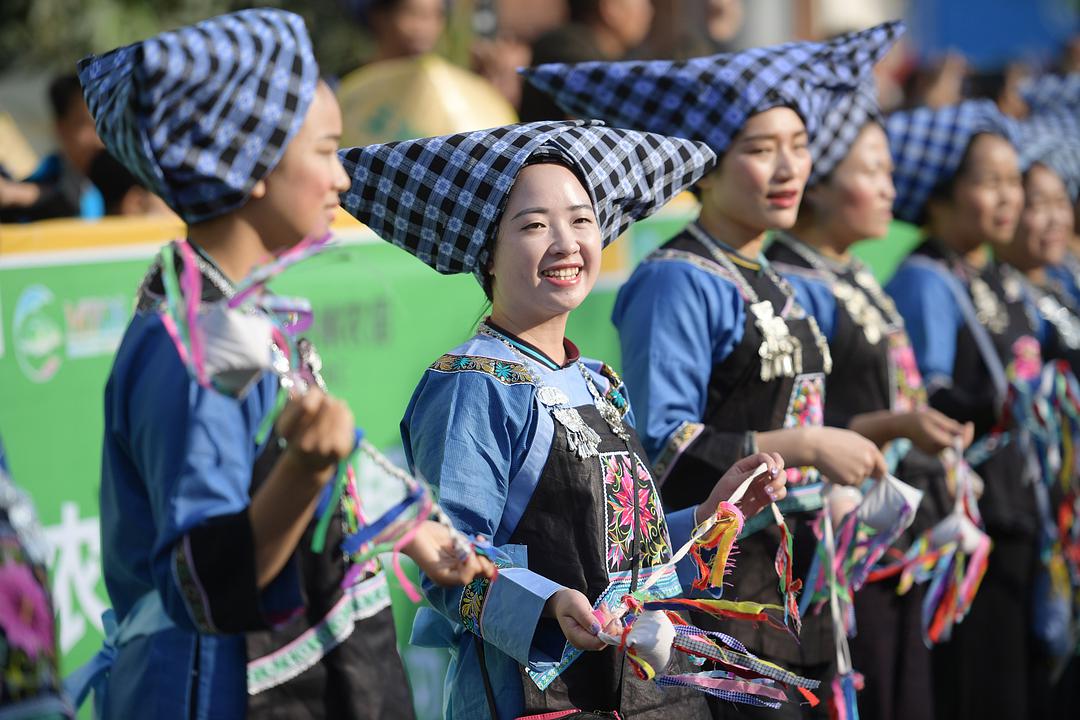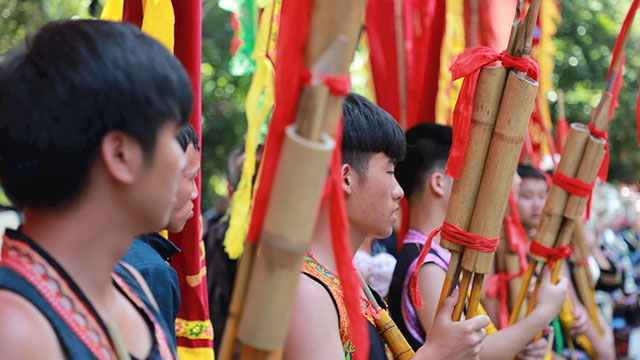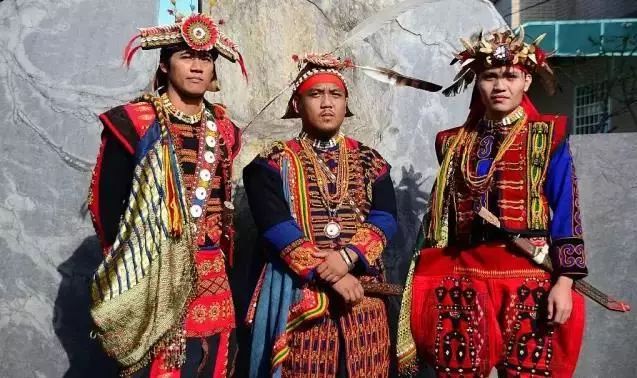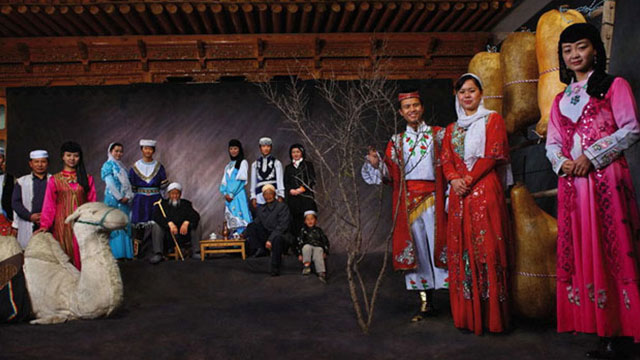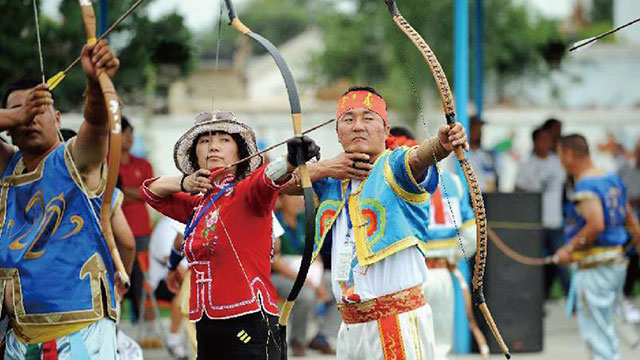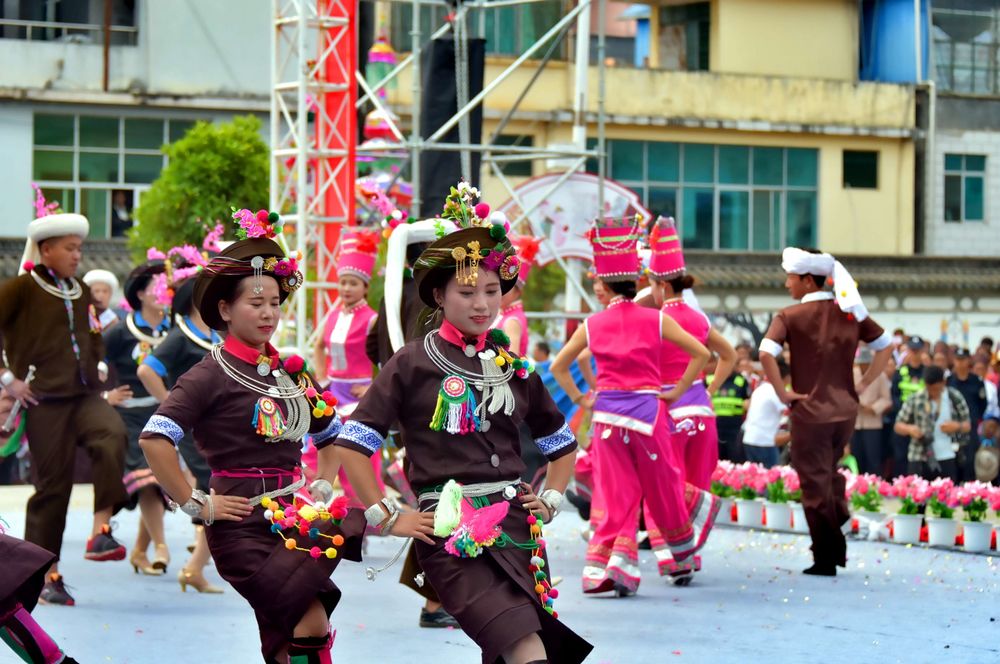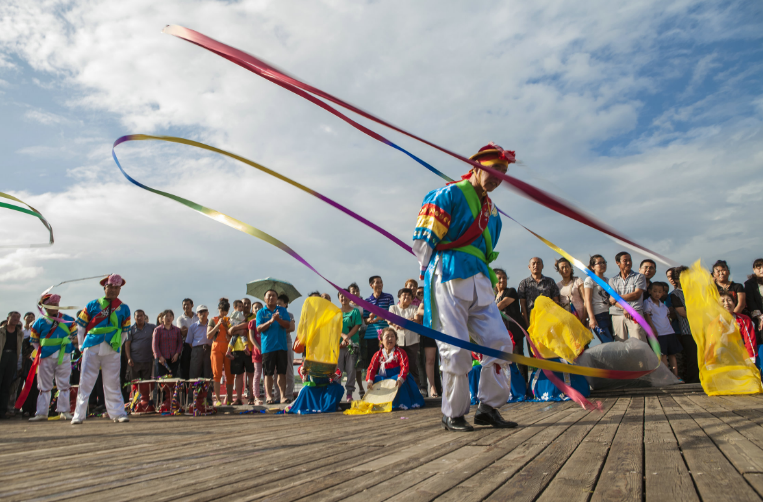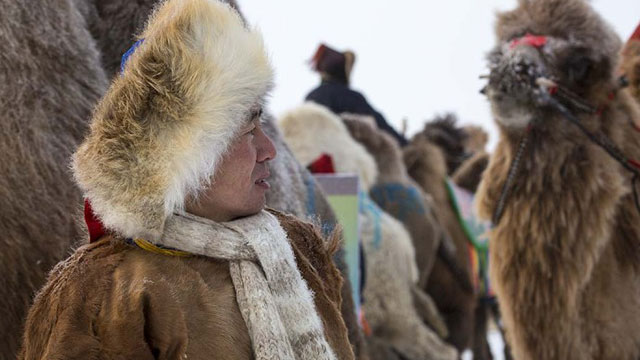Gelao Nationality
Gelao nationality, ethnic origin and ancient Liao (L ǎ o) It is related to people. The national language is Gelao language, belonging to the Sino Tibetan language family. There is no national language, and Chinese is commonly used. Gelao people worship their ancestors and worship the bamboo king, manwang's ancestors and mountain gods.
Gelao people are concentrated in Wuchuan and Daozhen, two Gelao and Miao Autonomous Counties and Shiqian County in the north of Guizhou Province, and the rest are scattered in more than 20 counties and cities such as Anshun, Pingba, Puding, Guanling, Qingzhen, Zheng'an, Fenggang, Songtao, western Guizhou, Liuzhi, Zhijin and Dafang.
According to the sixth national census in 2010, the total population of Gelao nationality is 550746.
Gelao nationality Wiki:
| Chinese name | Gelao nationality |
| Location | Mainly in Guizhou, scattered in Yunnan, Guangxi and Vietnam |
| languages | Gelao language, Chinese |
| written words | There was gelaowen |
| population size | 579744 (2000) |
| faith | Worship ancestors, believe in multi gods, Taoism and Buddhism |
| festival | On March 3 of the lunar new year, Qingming Duanyang Gelao Festival |
Family name
Gelao nationality was originally divided into many different branches, each with different names.
After the founding of new China, after consultation with representatives of Gelao nationality in various places and with the consent of the State Council, it was announced that it was uniformly called Gelao nationality in 1956.
In 1983, with the progress of ethnic identification and ethnic composition restoration, according to the national ethnic policy and with the approval of the government at or above the county level, more than 250000 people restored the ethnic composition of Gelao nationality.
history
Scholars agree that the origin of Gelao nationality is related to the ancient "Liao" (pronounced old) people. In terms of housing, clothing, diet, funeral, ear piercing and other customs, it also retains a large number of characteristics similar to those of the ancient Liao people. For example, the Gelao nationality in Wozi Township and Gaoyang Township, Puding County, Guizhou still retained the custom of "beating teeth" by the end of the 19th century.
The ancient Liao people lived in Southwest China very early. Before the Han Dynasty established the county, there were several tribal groups here, and Yelang was the most powerful. From 3 to fifth Century, the officials who moved to Sichuan by the Cong Fu were incorporated into the registered residence of the feudal countries and paid taxes to the feudal dynasty. In the 5th century, they were able to make metal spears and shields, gill tools and copper cuans, and woven them into fine cloth with hemp fibers. After the 7th century, the commodity exchange of Liao people in Sichuan became more and more frequent. The quality of Liao cloth was very good and became a tribute that must be handed over to the feudal dynasty. Until the reign of song Zhiping (the middle of the 11th century), some Liao lords still occupied a large amount of land, owned thousands of households dependent on farmers, and became feudal forces on the separatist side.
In the Song Dynasty, the economic development of Gelao nationality was unbalanced. The Gelao people living in the mountains of Chen, yuan and Jingzhou in Hunan still use slash and burn farming to produce corn and beans. If there is insufficient food, they will be supplemented by hunting. The Gelao nationality living in Pingba area has a variety of rice, with high output per unit area and considerable development in handicraft production. They have mastered the technology of mining cinnabar and produced various characteristic products. The more famous are the exquisite silver wine vessel "silver dove", the "ring cloth" woven from mulberry bark and the "non stop belt" woven with patterns, and the "thick stop spot" is sewn Gelao skirt, etc. All these show that the level of social productivity had developed to a certain extent at that time.
During the yuan and Ming Dynasties, most of the Gelao areas were governed by chieftains in the central dynasty, and some areas also retained the unique social and political system of Gelao - horse head system. The Gelao people in langdaiting (now Liuzhi special zone of Guizhou Province) call their local officials horse heads. The horse heads have horse head fields for salaries. When they go out on patrol, they take sedans, and an honor guard blows a trombone to open the way in front, showing their prestige. The descendants of Matou still enjoy a high social status in Gelao nationality. So far, they are known as "Matou Gelao" in Liuzhi area. The central dynasty also successively established military institutions such as Wei, Suo, Tun and Bao in Gelao areas. The "change of soil to flow" began in the late Ming Dynasty and was basically completed in Gelao area in the Yongzheng period of the Qing Dynasty.
In order to resist the cruel rule of feudal dynasties, the ancient Liao people, including the ancestors of Gelao nationality, once rose up many times to carry out armed struggle. In the middle of the 7th century, Liao people in Yazhou, Qiongzhou and Meizhou in Western Sichuan broke out a large-scale uprising because they opposed heavy labor. In the middle of the 9th century, Ge Liao (Gelao) in Rongzhou (now Yibin) and Luzhou (now Luzhou City) of Sichuan also resisted angrily due to the skillful and violent seizure of feudal officials, and fought all the way to Santai, Sichuan. By the middle of the 16th century, in the struggle to resist the Japanese invasion of dongnanhai, Gelao nationality living in Western Hunan, together with Tujia nationality and Miao nationality, was called to fight in Jiangsu and Zhejiang, and made contributions to the battle to defend the motherland. In the mid-19th century, the Miao and Han ethnic groups in Guizhou launched a "Xiantong uprising" against the Qing Dynasty. When the uprising passed the big dog farm inhabited by the Gelao people in Pingba County in the spring of the fourth year of tongzhi (1865), the Gelao people actively sent food, water and cooking for the uprising to support this righteous struggle. Gelao farmers in heizhai area of Anshun also directly participated in the uprising, which dealt a heavy blow to the rule of the Qing Dynasty.
Before 1949, land annexation in Gelao area was very serious, and most of the land was in the hands of foreign landlords. For example, in Pingzheng Township, Zunyi County, foreign landlords and rich peasants, who account for 9% of the population, occupy more than half of the land. The form of exploitation is mainly physical land rent, which is divided into fixed rent and living rent. The rent generally accounts for more than half of the harvest. When renting land, you have to pay a "deposit", which is equivalent to 50% to 200% of the rent. In western Guizhou, in addition to paying corn, opium, soybeans, tobacco rice (poppy seeds), pepper and other things every year, some of the tenant planting mountains have to work on the landlord's land for 50 to 80 days free of charge every year. Farmers in Changshi Township, Dading County spend almost a quarter of their production time every year feeding livestock, repairing houses, carrying grain, transporting coal, carrying sliding rods and so on. When the landlord's family has weddings, funerals and birthday celebrations, the tenant has to help and give gifts. Some landlords also practice the so-called "human rent", that is, landlords can deprive farmers of their personal freedom and detain farmers' children as slaves as the amount of land rent. Various kinds of heavy exploitation have overwhelmed the Gelao people. Of the 32 farmers in Tianba village, Zunyi County, 30 often have to pick stone garlic (a local wild plant) to satisfy their hunger. Dading County Mayor Shi township has people going out to escape from famine all year round. In 1945, 11 of the 52 Gelao families in Gelao village were forced to flee from famine.
The KMT government also strengthened the Baojia system and adopted the "joint security joint seat" in which one family broke the law and the all security joint seat to strengthen its rule. Exorbitant taxes and miscellaneous taxes are very heavy, including military grain, daily and monthly donations, shoes and socks for the army, district and township funds, self-defense donations and so on. According to the statistics of Gelao farmers in Anshun County, there are more than 50 kinds. In order to carry out the civil war against the people, they wantonly arrested Latin husbands, nominally stipulating "three Ding and one pumping" and "five Ding and two pumping". In fact, even the only son can not be spared. In order to facilitate its rule, the Kuomintang government also deliberately provoked discord, created ethnic disputes and carried out forced assimilation. The Gelao people are in the abyss of suffering.
In 1935, the workers' and peasants' Red Army led by the Communist Party of China passed through western Guizhou, Dading, Zunyi, Renhuai and other places, leaving revolutionary fire for the Gelao people there. In the bitter years when "the landlords have grain in their warehouses and the poor have no rice to cook soup", the Gelao people have deeply realized that only by supporting the Red Army to win the war can the workers and peasants be liberated ". In October 1943, the Buyi and Gelao people in Zhenfeng County rebelled against the rule of the Kuomintang and once occupied the county. In 1948, the Han and Gelao farmers in Li village and Tianba village of Zunyi County, together, broke into the landlord's house and distributed 70000 to 80000 kilograms of grain. Young and middle-aged Gelao people in Pingzheng village, Zunyi County and other places also armed against conscription, forcing Kuomintang minions and Township Chiefs not to enter the village and forcibly catch strong men.
Economics
Before 1949, Gelao nationality was mainly engaged in agriculture. Corn is the main crop, but the yield per mu is low, and the yield per mu is only eight or ninety kilograms. In addition, it also produces rice, wheat, sweet potato, etc. Without water conservancy projects and relying on rainwater irrigation, water, drought, hail, insects, animals and other disasters are serious. Collecting Tongzi and weaving bamboo and straw sandals play an important role in the economic life of Gelao nationality. Due to the dumping of foreign yarn, the family handicraft industry of Gelao nationality, which used to spin "iron flute cloth", has gradually declined.
As early as the Qing Dynasty, a group of professional blacksmiths appeared among the Gelao people. For example, according to the records, the Gelao people in huangpingzhou and Liping Prefecture "do more iron workers", some Gelao people in Pingyuan Prefecture and Dading Prefecture "make plows for their industry", and the shotguns made by Gelao craftsmen in Western Hunan have a range of more than 20 feet. Therefore, in the history books, the Gelao people in some places are called "iron Gelao". This iron striking skill has been retained in some Gelao people. For example, among the 26 Gelao people in longzhai village in Langdai county (now Liuzhi area), Guizhou Province, there are more than 10 iron striking families. The iron products produced by Gelao people are loved by the local people of all ethnic groups. However, with the emergence of a large number of iron products with high quality and low price in the market, there are few people engaged in iron making at present. The stone carving craftsmen of Gelao nationality have exquisite skills. Most of the stone carvings are used for stone outline carving.
The smelting industry of Gelao nationality has always been prosperous. Wuchuan, inhabited by Gelao nationality, is rich in cinnabar. The "Daqing cave" with a mining history of more than 2000 years is now preserved in Wuchuan, and there are ancient rocking boats for mining dansha in the cave. According to historical records, in the tenth year of Sui Dynasty (AD 614), Tian Zongxian, the prefect of Central Guizhou, mined mercury and cinnabar at the foot of Wuchuan Yanfeng, and received 190.5 kg of mercury from the imperial court. According to Tongdian · food and goods code, the Tang Dynasty made a system: "the counties in Tianchang often pay tribute every year, and the counties in Central Guizhou pay tribute to ten kilograms of cinnabar." Wuchuan, which is inhabited by Gelao people, is also one of the earliest areas in China to refine mercury. The cinnabar mining of Gelao nationality has a long history and has never been exhausted since the Shang and Zhou dynasties. The "treasure King Bodhisattva" believed by Gelao nationality is a cultural phenomenon formed in it. Since the 1980s, more than 2000 households of Wuchuan Gelao people have built sheds, mined and refined mercury in mines, with a total of 685 tons of cinnabar mercury.
Politics
The founding of new China in 1949 opened a new page in the historical development of Gelao region. Since the establishment of two Gelao nationality townships in Pingzheng township of Zunyi County and Anliang township of Renhuai County in 1956, the State Council successively established Wuchuan Gelao and Miao Autonomous County and Daozhen Gelao and Miao Autonomous County in Wuchuan and Daozhen counties where Gelao people live, and successively established more than 20 nationality townships in areas where Gelao people live.
After several administrative divisions adjustment, by 1992, there were 18 Gelao nationality and nationality townships jointly built by Gelao nationality and other nationalities. The National People's Congress, local people's congresses at all levels and government agencies all have Gelao people's deputies and cadres to participate in and exercise the right to be masters of the country. In Wuchuan Gelao and Miao Autonomous County, Gelao nationality has served as the chairman and county head of all previous people's congresses. Among the county-level and Deputy county-level cadres, Gelao nationality cadres account for more than 50% of the number of cadres at the same level; Among the township level leading cadres, Gelao cadres also account for more than 60% of the number of cadres at the same level; The team of technical cadres is growing and playing a more and more important role in the economic and social development of Gelao area.
Culture
faith
Gelao people worship their ancestors and worship the bamboo king, manwang's ancestors and mountain gods. There are wizards who specialize in offering sacrifices, praying for blessings and longevity, returning ghosts and surpassing the dead.
Gelao people start their own businesses and live in the mountains. Their clothing, food, shelter and transportation are closely related to the mountains and forests, resulting in the concept that everything has a spirit. Some people worship ancient trees and boulders. They offer wine, meat and Ciba on the 14th of the first month and the third day of March to pray for the well-being of their children and grandchildren. During drought, flood, disease and insect disasters, they hang up good donations, invite Taoists to set up altars for Jiaojiao, and pray for the gods to protect peace.
The largest and thickest ancient tree in the mountain forest near my residence is often sacrificed and worshipped as a sacred tree. Once selected, the area will be closed to prohibit any improper behavior, including tree cutting and grazing, which objectively protects the local vegetation resources and maintains the ecological environment.
language
Gelao people have their own language. Gelao language belongs to Sino Tibetan language family. It is close to Miao language in phonetic system, and close to Zhuang and Dong language in phonetic and grammar. It has a small number of cognates with Miao Yao language and Zhuang Dong language.
There is a view in the academic circles that it is more appropriate to regard Gelao language family as an independent language family in the Sino Tibetan language family, and its name can be called Liao language family or Gelao language family. Gelao language is divided into four dialects, which are customarily called "draft dialect", "Hagai dialect", "DORO dialect" and "Ao dialect". There are great differences among the dialects of Gelao language, and the distribution of local dialect is staggered. Several Gelao dialects often coexist in a county.
In terms of language use, only dagouchang in Pingba County, Guizhou Province, wanzizhai and heizhai in Xixiu District, Anshun City, Xinzhai in Puding County, maao in Guanling County, Judu in Liuzhi, Hongfeng village, Pudi Township, Dafang County, Yueliangwan in Malipo County, Yunnan Province and Sanchong Gelao in Longlin Autonomous County, Guangxi Province have relatively complete languages.
According to the survey, at present, there are no more than 6000 Gelao people who take Gelao language as their mother tongue, accounting for only 1.1% of the total population of Gelao people. Most Gelao people use Chinese as their main communication tool. A few members also speak local Miao, Buyi, etc.
Gelao people do not have their own language and generally use Chinese.
Architecture
The living conditions of Gelao people vary according to the terrain. Most of them live in the same clan, and each family of a clan builds houses adjacent to each other to form a village. The form of housing structure and building materials vary according to its economic conditions, population and geographical environment. Gelao people living in hilly, valley and Pingba areas mostly build houses near mountains and rivers, and their houses are generally high; Gelao people living in high mountains usually choose sunny shelter to build, and most of the houses are relatively low. Often pay attention to the choice of house address, there is the saying of "mountain management of people and water management of wealth".
When building a house, the height of the house likes to choose the size with the mantissa of eight. Take the middle column as an example, take one foot, six tops (feet) and eight, and so on. In fact, it selects homonyms to express its good wishes for the family. The styles of houses include single room, two rooms, long three rooms, long five rooms, double hall, triple hall, Sanheyuan and quadrangle. Except for the single room and two rooms, the other houses use the one in the middle as the nave and set up family niches, which are specially used for sacrifice and reception. Generally, no floor slab is laid. The houses on both sides are called "small two rooms", which are usually divided into two front and rear rooms. The front one is used as a kitchen and the back one as a bedroom. There are many sky and ground floors. The ground floor is about one meter high and goes up by ladder. Under the ground floor, sundries can be stored or used as a chicken and duck house. The middle hall is more concave than the bedrooms and kitchens on both sides to form a hall opening. Some people who built "stilted buildings" near the mountain set railings and corridors, lived upstairs and made stables downstairs. In the past, most of them were straw houses with civil bamboo structure. After the founding of new China, after land reform, social and economic development, rural housing has been improved day by day. In the 1970s, houses with stone and wood structures were popular for a time. Since the 1980s, due to the improvement of people's living standards, most brick and stone tile houses and buildings have been built. In places with convenient transportation, reinforced concrete multi-storey buildings have gradually sprung up.
Clothes & Accessories
The clothing culture of Gelao nationality has its own characteristics.
In the Qing Dynasty and before, most of the clothes were made of home woven linen dyed blue and blue. Men wore collarless long shirts, copied lapels, long to the knee, large and short sleeves, and often tied belts. When working, they lifted the front and rear corners of the clothes and tied them at the waist.
Women's clothes are short, with cut placket and lace. According to historical records, about the middle of the 19th century, Gelao women's tops were only waist length, with scaly patterns embroidered on the back of the sleeves and a pleatless long bucket skirt under them. The whole skirt was divided into three sections. The middle section was woven with wool and dyed red, and the upper and lower sections were mostly woven with hemp. Generally, there were cyan and white stripes, and the outer cover was a cyan sleeveless robe. The robes were short in front and long in back. They were embroidered with patterns. When wearing, they were put on and off from the head, Wear hook pointed shoes.
After the Republic of China, all ethnic groups had cultural exchanges, learned from each other, learned from each other, and their aesthetics gradually changed with the development of society. No matter men, women, young and old, their costumes were gradually consistent with the local Han nationality.
Nowadays, Gelao people's daily clothes are increasingly diversified, personalized and various styles. The texture has developed from simple cotton cloth and polyester card to wool, hemp yarn and polyester. The Gelao people in rural areas also wear more clothes in one season. They will wear their own national costumes only in various festivals and celebrations.
diet
In terms of diet, the staple food is corn (mountainous area) and rice (Pingba area), followed by various beans, wheat, buckwheat and potato, and likes to eat hot and sour food and glutinous rice Baba. Among the non-staple foods of Gelao nationality, glutinous rice cake is regarded as a precious food. It is used to "worship the ancestors" on New Year's festivals, entertain guests, send relatives and friends on the Dragon Boat Festival and offer new gifts on the Double Ninth Festival. This custom has been preserved to this day.
Zajiu is also the characteristic diet of Gelao people. When making, corn, wheat, millet and sorghum are used as raw materials. After cooking, they are fermented and loaded into tanks. When installing the cylinder, first use two water bamboo poles with big fingers and about one meter long (one of them is bent with fire). Except for a bamboo joint at the top, the other bamboo joints are emptied, inserted into the cylinder and then sealed. The longer the sealing time, the more mellow the wine taste. When drinking, empty the top bamboo, straight the rod into the air, and bend the rod as a suction device. Whether banquet or usual hospitality, they suck according to the dignity of the old and the young. The draft of Zheng'an county annals of the Republic of China contains a poem that "ten thousand pearls are collected in a jar, and the princes bow their heads here. The five dragons hold Optimus Prime and suck up the water of the Yellow River.".
The production of Camellia oleifera is also very special. First stir fry green tea with lard in the pot, and then boil it with water. When the water is slightly dry, push the tea with a wooden ladle into a paste, which is called "tea soup". When drinking, depending on the volume and intensity, fry the tea soup with pig oil, add water to boil, and then put lard, oil residue, salt, pepper, cooked sesame, soybean and peanut powder. Its flavor is strong, fragrant and unique. Today, Daozhen oil tea has formed a series, mainly including oil tea eggs, oil tea dumplings, oil tea porridge, oil tea noodles, etc.
etiquette
All weddings and funerals should be celebrated with a banquet. Generally, there are twenty or thirty tables, and more than a hundred tables. Because there is often no preparation in advance, the funeral table is generally not particular about it, and the hanging guests don't care. There is the custom of "not welcoming or sending funeral rites, but from sending affection". In the past, when the economy was poor, it was not easy to handle seats. There was a saying that "it is now said in the funeral hall that it is difficult to recruit men to marry women, and it is difficult to persuade ghosts at the expiration of the birth Dynasty".
Since the 1980s, the special etiquette "three Yaotai" for entertaining distinguished guests has appeared in Sanqiao area of Daozhen Autonomous County. "Yaotai" is a dialect, which means the end. "Sanyaotai" means inviting distinguished guests to dinner. A meal needs three sets (Times) to be finished. The first one is "welcome the wind and wash the dust". The food is nine plates of fruit cakes. Generally, there are nine kinds: Milky crisp food, Tianxing rice cake, hundred flower crispy skin, red hat cake, beauty mole bubble cake, walnut, peanut, sunflower and dry persimmon. Each person is equipped with a bowl of tea. The host and guest talk freely while drinking tea and snacks. The second after tea is "Eight Immortals drunk". The food is usually nine plates of pickled vegetables and cold dishes for wine, and the wine is a small pot of self brewed Baogu wine. After the wine and dishes are served, the guests and hosts will be in place after ordering fragrant paper to honor their ancestors. The first cup is a toast to guests, the second cup is a blessing wine, and the third cup is a filial piety toast. After the three cups, wine songs will cheer up and drink according to the amount, with a warm atmosphere. The third main table is called "Four Party reunion", and nine large bowls are filled with meat based dishes until the guests are full; The host let the guests leave the table. The "three Yaotai" banquet of Gelao nationality has extremely rich dishes and exquisite dining etiquette, which fully reflects the unique flavor and cultural connotation of Gelao diet and reflects the enthusiasm and simplicity of Gelao people.
literature
The folk literature of Gelao nationality includes legends, poems and proverbs.
Folk stories mostly tell about the birth of heaven and earth, the origin of Gelao nationality and the wisdom, kindness, diligence and courage of heroes and working people, such as making heaven and earth, ah Yang brothers and sisters making human smoke, bamboo king, brave girl, deaf brothers and blind brothers stealing sheep, etc.
Sports
The cultural and sports activities of Gelao nationality are mainly carried out during the Spring Festival, including beating thin eggs, grinding autumn, holding dragon eggs, beating chicken, etc.
Playing "Mei egg" is an ancient and unique mass sports of Gelao nationality, which has been included in the traditional sports competition of ethnic minorities by ethnic departments.
Gaotai lion dance is a popular entertainment activity among the Gelao and Miao people in Daozhen Autonomous County. In 1956, Daozhen Gelao and Miao Autonomous County organized a team to participate in the folk literature and art performance in Guizhou Province and won the second prize. In 2003, he won the silver medal in performance at the 7th National Minority Traditional Sports Games held in Yinzhou City, Ningxia.
Art
music
Gelao people often express their feelings with songs during production and labor, social occasions of young men and women, festivals, celebrations and banquets for relatives and friends, including "slapstick song", "bugle", "folk song", "disc song", "ancient song", "love song", "pastoral song", "boudoir resentment song", "long work song", "Crying Marriage song", "quit smoking (opium) song", "quit gambling song", etc. The poetic style is three character, five character and seven character, but most of them are seven character, which has both Fu Bixing and rhyme. It is similar to the seven character quatrain poetic style, and also has the long and short sentence form of Gelao language singing. It combines philosophy with lyrics, shows interest in singing, and has a strong flavor of life. For example, the "winding song", which is often improvised and expresses things in life in the form of songs. The lyrics are vivid, humorous, flexible and diverse. They are not only interesting and knowledgeable, but also beautiful in rhyme and form their own style.
Bronze drum, ox horn, flute and hulusheng are commonly used musical instruments in the history of Gelao nationality. Paomu tube is a unique musical instrument of Gelao nationality. It is made into a tube by poking the core with more than two feet long paomu, chiseling two holes, and inserting a bamboo Suo tube at the top. When playing, it makes a sound of "Wow, wow", so Gelao nationality calls it "wow". "Wow" can only be played from the end of autumn harvest to the 15th day of the first month. It is not used for collection in the rest of the time.
dance
The dances of Gelao nationality include "dingwenglo", "toasting dance", "wine dance", "washing basin and coat dance", "stepping on the hall dance", "sacrificing mountain god dance", "sacrificing tianniang dance", etc.
"Dingwenglo" is a dance that expresses the traditional custom of Gelao young men and women to express love and choose lifelong partners during the social period of the first lunar month.
"Wine dance and kiss toast dance" is the dance of Gelao nationality in Lalu village, Qingshan, Dafang County. It is derived from the relevant etiquette in the wedding.
"Wine dance" is a joyful dance that shows the guests drinking and smacking wine when attending the wedding.
"Kiss and toast dance" is to show the bride's shy attitude of covering her face with sleeves when she gets married.
"Washbasin and coat dance" is popular in Wuchuan Autonomous County. It is a unique art form of Gelao nationality.
"Stepping on the hall dance" is a dance performed in funeral ceremonies.
"Mountain God Worship Dance" is a dance performed by Liuzhi Gelao people when they worship mountain gods on March 3 every year.
"Tianniang dance" is a dance performed by women and children in Hakka fields led by their families during the annual "new eating Festival" in Shuicheng, Liuzhi and other places.
Theatre
There are two kinds of Gelao Drama: Nuo opera and local opera.
Nuo opera is a kind of exorcism ceremony, which was introduced from the Central Plains. It is called "Nuo opera" because of its certain dramatic plot. When Nuo opera disappeared in the Central Plains, Nuo activities were still preserved among the people in Guizhou. Nuo opera of Gelao nationality is mainly popular in northern and northeastern Guizhou. Accompaniment instruments include gongs, drums, ox horns, etc. performers must wear masks.
Local opera evolved from the popular "military Nuo" in the weisuotun army in the Ming Dynasty. It is popular among Gelao people in Central Guizhou. It is mostly based on war stories of previous dynasties to show the martial spirit and entertain themselves. The performance place is not on the stage, not indoors, but on the ground outdoors, so it is called "local opera".
custom
festival
The most important festivals of Gelao people in a year are "Spring Festival", "Qingming Festival", "mountain sacrifice Festival", "Dragon Boat Festival", "eating new festival", "Mid Autumn Festival", "Double Ninth Festival", "ox King Festival", "bird worship Festival" and "insect catching Festival", among which the most solemn is the Spring Festival. During the Spring Festival, Gelao nationality, like the Han nationality, also worship their ancestors. The whole family keeps the year old and has its own characteristics at the same time. Gelao people everywhere have to make glutinous rice cakes to worship their ancestors on New Year's Eve. There are different sizes and quantities of cakes. Some use a large one, some add three or four small ones on the large one, and some are three stacks, with 3, 5 and 7 cakes each. The time of offering rice cakes to ancestors is different, some to the first day, some to the second day, and some to the fourteenth day. "Bird worship Festival", also known as "bird love festival", is held in Shiqian County in May and June every year.
Except for a few areas such as Guanling and Qinglong, Gelao people generally offer sacrifices to mountain gods on the third day of March. The mountain gods are all attended by men, most of which are whole village activities, but there are differences in form and etiquette. Gelao people in Anshun, Puding and Zhenning also killed chickens and prepared wine to worship "seedling land" on the sixth day of June.
The new festival is celebrated by Gelao people all over the country, with different times and similar contents. It is a festival that Gelao people pay more attention to. Picking new grain, sacrificing ancestors with new grain, and holding "release" activities to release animals to nature are the central content of this festival, and people can start eating new grain only after the festival. When the new eating Festival comes, every family should go to the fields to pick new crops, pick new ears of grain, cook new rice, and prepare wine to honor their ancestors, so as to thank their ancestors for their kindness of pioneering and cultivating land and benefiting future generations. Then everyone eats new and celebrates the harvest of the year.
Gelao people everywhere also celebrate the "ox King Festival" in early October, also known as "respecting the ox King Bodhisattva" and "sacrificing the ox king". On this day, Gelao people not only kill chickens and prepare wine for the king of cattle, but also let the cattle rest, feed the cattle with the best feed, beat two cibabs with top-grade glutinous rice, hang them on the horns of the cattle, and then lead the cattle to the water. If there are no ponds, wells and paddy fields nearby, they also need to draw a basin of water at the door of their house, let the cattle "look in the mirror", and then take down the cibabs to feed the cattle and give the cattle "longevity". In some places, cattle will be dressed in red and decorated, and firecrackers will be set off to express congratulations.
marriage and love
Before the founding of new China, all branches of Gelao nationality did not marry each other and implemented the system of intra branch marriage. However, the same clan was not allowed to start a marriage and was used to the marriage of aunts or aunts. Young men and women are generally engaged at the age of 14 or 15, and there are even "back marriage" and "finger belly marriage". In the Gelao wedding ceremony, there are various forms. In most areas, there are traditional customs such as "men don't welcome in person" and bride walking, as well as different rooms for newlyweds during the wedding. After the founding of new China, with the long-term mixed living of Gelao nationality and Han, Buyi, Yi, Miao and other nationalities, more and more young people have entered into inter ethnic marriage and registered marriage with relevant government agencies through free love.
Gelao people have always practiced monogamous small families, and men and women have equal status in the family. Some discriminatory taboos against women, such as not going upstairs and not crossing the gate, have been abolished. If the parents die and there are more brothers, respect the eldest brother as the parent. There is a saying that "the eldest brother is the father and the eldest sister-in-law is the mother". If the parents are alive and the brothers are separated, the parents generally live with the youngest son, and the property is equally distributed among the brothers; If the youngest son is unmarried, he can get more points to compensate for the need for marriage.
funeral
Gelao's burial styles are unique and diverse, and vary from place to place. Rock cave tomb, Sarcophagus, slate, vertical burial and inverted burial are the traditional burial styles of Gelao. "Singing with drums, men and women jumping around corpses" is the traditional funeral ceremony of Gelao.
For example, in Zunyi, Renhuai and other places in Guizhou, the Gelao people's step on the hall dance was first performed in front of the grave, and then gradually changed to the mourning hall. When stepping on the hall dance, the dancers work in groups of three, playing Lusheng, money pole and silk knife respectively, singing in front while dancing, and everyone goes hand in hand behind. When dancing, the body is slightly bent and jumps back and forth. The dance step is slightly heavier with the right foot landing, forming a slow step. The dance process is mainly completed by the change of dancers' formation. The formation names include "four petaled flower", "Liu Chuanyu", "plum blossom array", etc. The crowd gathered around the coffin, singing and stumbling with their feet. From time to time, they shouted "Oh, man", indicating that they trampled and drove away the ants and crows that bit and pecked the corpse of the ancestor. In most areas, on the eve of burying the dead, filial piety songs should be sung in front of the dead. When relatives come to offer sacrifices, the bereaved family must toast and thank them. Don't lose your money when you go to a funeral. During burial, except that in some areas, ghost masters should be invited to choose the day and place to chant scriptures as "Daochang" and "animal delivery" (the ceremony of paying animals to the dead), they generally do not choose the day and place.
Gelao's funeral customs also retain the characteristics of traditional funeral to varying degrees.
taboo
Gelao taboos vary from place to place, especially in the first month. For example, it is forbidden to sweep the floor, carry water, cook raw food, ride horses, plough fields, pour sewage outside the door, etc. Some people also avoid moving soil and transplanting seedlings when there is thunder in "cow day" and "horse day". Married daughters go home, avoid going upstairs and sweeping the floor. With the development of the times, these taboos have not been strictly followed by people.

Gelao Nationality
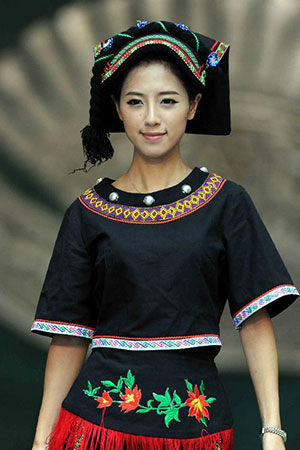
Gelao nationality
-
Han Nationality
The Han nationality is the main ethnic group in China. The Han nationality, formerly known as Han people, was named after China's Han Dynasty, which used to be called "Huaxia" or "Zhuxia". Whether in politics, military affairs, philoso - Han Zu
Views: 199 Time 2021-03-07 -
Manchu Nationality
The Manchu population is distributed all over the country, mainly in Liaoning, Hebei, Heilongjiang, Jilin, Inner Mongolia Autonomous Region, Beijing and other provinces, autonomous regions and municipalities directly under the central government, while ot - Man Zu
Views: 45 Time 2021-03-07 -
Hui nationality
Hui is a minority with a large population in China, with a total population of 10586087 (2010, excluding Taiwan Province), which is distributed in 31 provinces, autonomous regions and municipalities directly under the central government. Ningxia Hui Auton - Hui Zu
Views: 56 Time 2021-03-07 -
Buyi Nationality
Buyi Nationality, a relatively large minority in Southwest China, has the Buyi language as its national language. It belongs to the Zhuang Dai branch of the Zhuang Dong language family of the Sino Tibetan language family. It is closely related to the Zhua - Bu Yi Zu
Views: 37 Time 2021-03-07 -
Dong Nationality
Dong nationality (Dong Language: gaeml) is a minority nationality in China. The national language is Dong language. It belongs to the Dong Shui language branch of the Zhuang Dong language family of the Sino Tibetan language family and believes in many god - Dong Zu
Views: 62 Time 2021-03-07 -
Yao nationality
Yao nationality, one of the oldest nationalities in China, belongs to the Yao language branch of Miao Yao language family of Sino Tibetan language family, the Miao language branch of Miao Yao language family of Sino Tibetan language family, and the Dongsh - Yao Zu
Views: 104 Time 2021-03-07 -
Gaoshan Nationality
Gaoshan Nationality mainly lives in Taiwan Province of China, and a few scattered in coastal areas such as Fujian and Zhejiang Province. Gaoshan ethnic groups mainly live in the mountainous areas in Central Taiwan, the longitudinal valley plain in the Eas - Gao Shan Zu
Views: 45 Time 2021-03-07 -
Salars Nationality
Salar is one of the ethnic minorities who believe in Islam in China. The national language is salar. It belongs to the Ukrainian group of the West Hun branch of the Altaic Turkic language family. Some people also believe that it belongs to sarul dialect. - Sa La Zu
Views: 80 Time 2021-03-07 -
Sibe Nationality
Sibe people is an ancient ethnic group with a long history among China's ethnic minorities. Xibo nationality originally lived in Northeast China. During the reign of Qianlong, the Qing government recruited some Xibo nationality to move west to Xinjiang to - Xi Bo Zu
Views: 46 Time 2021-03-07 -
Achang Nationality
Achang Nationality is one of the seven ethnic minorities unique to Yunnan and with a small population. The national language is Achang language. It belongs to the Tibetan Burmese language family of the Sino Tibetan language family. The language branch is - A Chang Zu
Views: 59 Time 2021-03-07 -
Korean Nationality
The population of Korean nationality is 1830929 (2010), mainly distributed in Jilin, Heilongjiang and northeast Liaoning, and mainly lives in Tumen River, Yalu River, Mudanjiang, Songhua River, Liaohe River, Hunhe River and other basins. Among them, the K - Chao Xian Zu
Views: 42 Time 2021-03-07 -
Ewenki Nationality
Ewenki (Russian: Эвенки, Tungus (formerly known as Tungus or Soren) is a nationality in Northeast Asia. It mainly lives in Siberia, Russia and Inner Mongolia and Heilongjiang provinces of China. Mongolia also has a small amount of distribution. In Russia - E Wen Ke Zu
Views: 48 Time 2021-03-07
